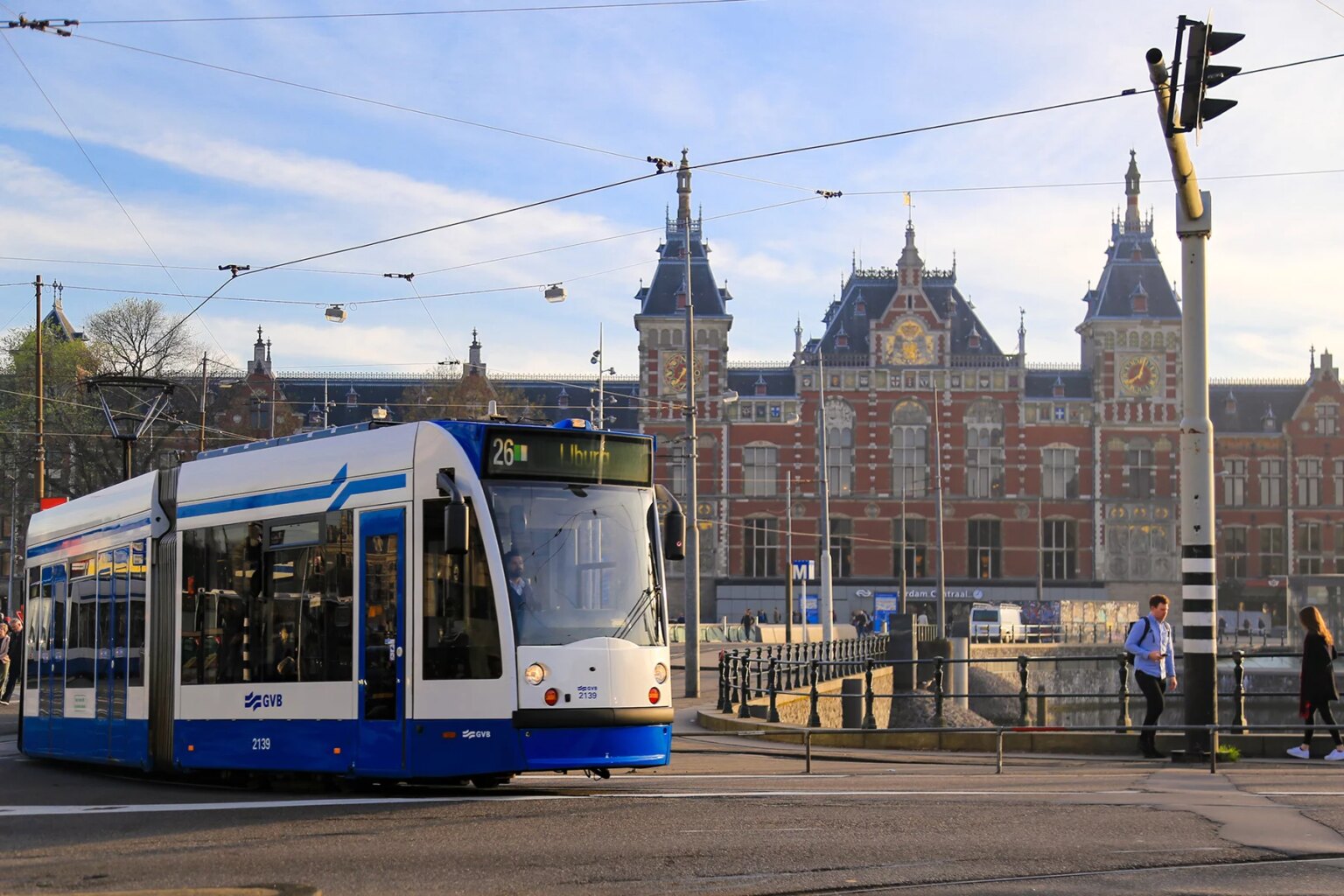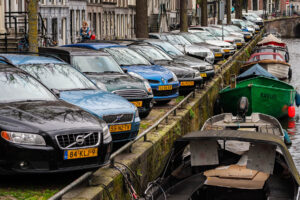For many expats arriving in the Netherlands, Dutch transportation means one thing: the bicycle. But while the Dutch have created the best cycling infrastructure in the world, they’ve done some great things with their public transit system, too. So whether you’re looking to take a train to Tilburg or a bus to Bloemendaal, it’s easy getting around the country. To help you on your way, this guide to public transport in the Netherlands includes the following information:
- An overview of Dutch public transportation
- The OV-chipkaart
- Public transportation apps in the Netherlands
- Train travel in the Netherlands
- Taking the bus in the Netherlands
- Taking a Dutch taxi
- Coach travel in the Netherlands
- Dutch airports
- Other methods of public transportation in the Netherlands
- Public transportation discounts in the Netherlands
- How disability-accessible is public transportation in the Netherlands?
- How environmentally friendly is public transportation in the Netherlands?
- Public transportation safety tips in the Netherlands
- Making a public transportation complaint in the Netherlands
- Useful resources
Omio
Want to fly away from it all? Or maybe you're looking for a family adventure by train? Wherever you're going, Omio can help you find the best deals for your journey. This one-stop shop lets you compare a range of transport modes, explore new destinations, and buy tickets at the touch of a button. Wherever adventure takes you, get there with Omio.
An overview of Dutch public transportation
Generally speaking, the Dutch public transportation network is clean, efficient, and relatively cheap. The local train network – operated by NS (Nederlandse Spoorwegen) – covers much of the country and you can move between cities cheaply. Other towns and villages are connected by bus links, while the northern islands have ferry access.
In larger cities, you’ll find either a tram or a metro system (or both), while smaller cities and towns have bus networks connecting suburbs with central areas. These networks are operated locally. However, wherever you are in the Netherlands, you’ll be able to use your OV-chipkaart, the national smart-card payment system for public transportation. Disabled travelers are generally well-catered for, and public transport stops and stations are usually near each other. This lets you seamlessly move between transport modes during your journey.
The OV-chipkaart
The first thing you need to know about public transportation in the Netherlands is the OV-chipkaart. The OV-chipkaart (OV stands for openbaar vervoer, or public transport) is the Dutch smart-card payment system that operates across the country on all public transport options. There are two types of OV-chipkaart: anonymous and personal. Anonymous cards can be bought and topped up from machines and ticket offices at train and metro stations. Personal cards need to be purchased online, and you will need to provide a photo for the card. These cards can be topped up online or at a ticket machine. Alternatively, you can sign-up for automatic top-ups when your balance falls below a certain amount.
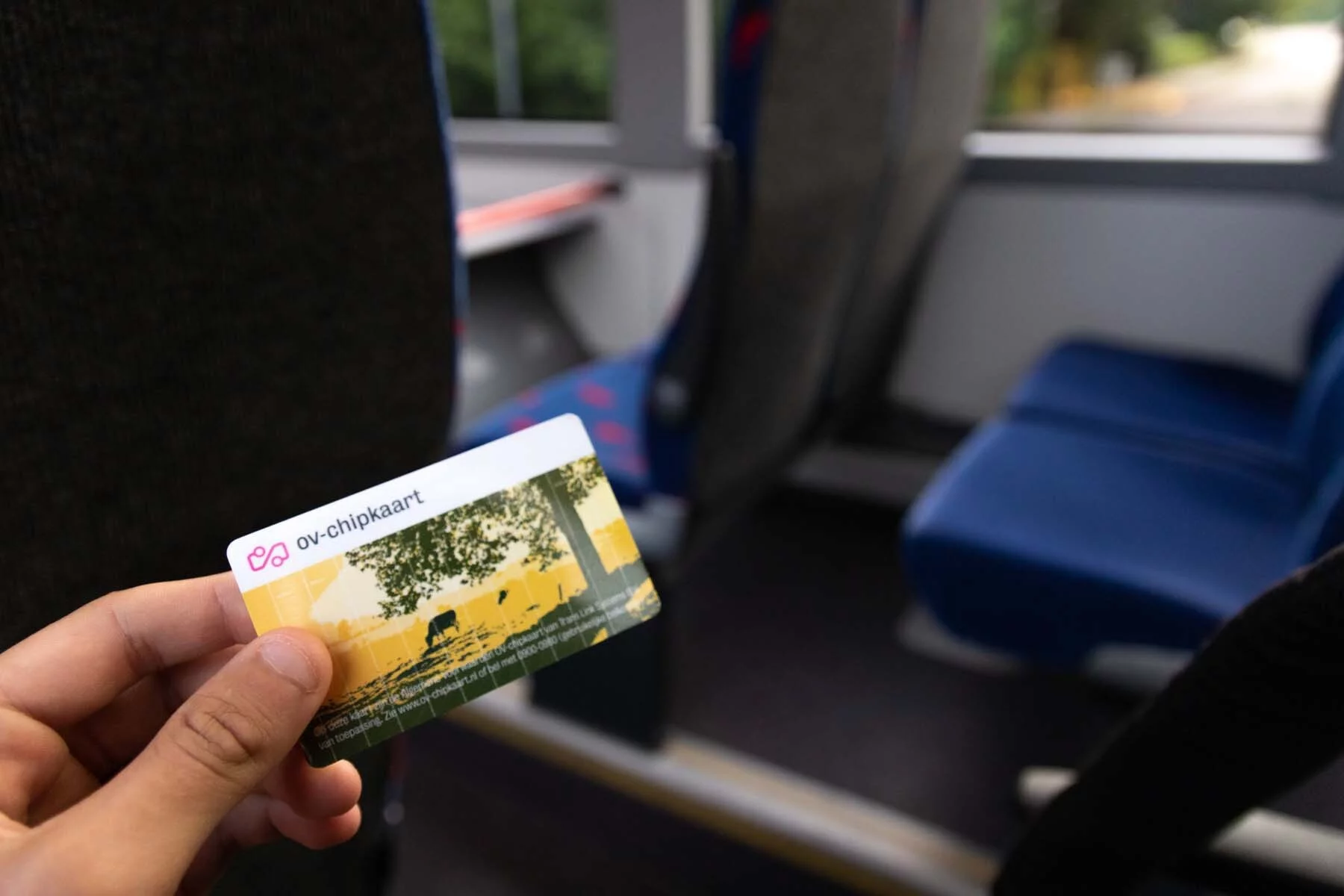
Journey costs are determined by the distance of your journey. When you check in, a boarding fare is debited from your card. This fare varies depending on the mode of transport. When you check out at your destination, you will be refunded this boarding fare, minus the charge for the kilometers you’ve traveled. However, if you fail to check out, you will have to pay the whole boarding fare, up to €20. For more information, visit the OV-chipkaart website.
Tips for using your OV-chipkaart
Before you use your OV-chipkaart, here are some things you should know:
- Don’t forget to check out if you want to avoid any unexpected journey fees.
- Products like monthly passes or season tickets can be loaded onto your personal OV-chipkaart. These tickets can be bought online, but you’ll need to manually load them onto your card at a designated upload point or one of the yellow OV-chipkaart machines.
- If you’re moving between transport modes/operators as part of the same journey, you’ll need to check out and then check back in again.
- Students can apply for discounts using their OV-chipkaart, so make sure you aren’t overpaying for your transport if you’re still in education.
Public transportation apps in the Netherlands
One of the best ways to plan a journey in a new country is by looking up your options online. The Netherlands has a wealth of public transport apps, including:
- 9292 – this app and website allows you to plan your journey in detail, with options for walking, cycling, trains, trams, and buses. It also allows you to check fares and order credit online.
- NS – the national train app has an in-built journey planner to organize your train travel. It also keeps you up to date on delays and cancellations.
- Omio – this website and app allow you to explore and book different train, bus, and air fare options, particularly handy if you’re making a longer journey.
- ov-chipkaart.nl (website only) – on the OV-chipkaart website you can order a personal transport card, check your balance, print travel declarations, and manage subscriptions.
Train travel in the Netherlands
When it comes to traveling long distances in the Netherlands, the train is by far the most popular form of public transport for the locals. This is largely thanks to the quality of the local network, which is one of the busiest in the world. Around 611,000 people currently travel by train each day, down from 1.3 million in 2019. Most of the country is within easy access from the rail network, although connections are generally more limited in the north of the country.
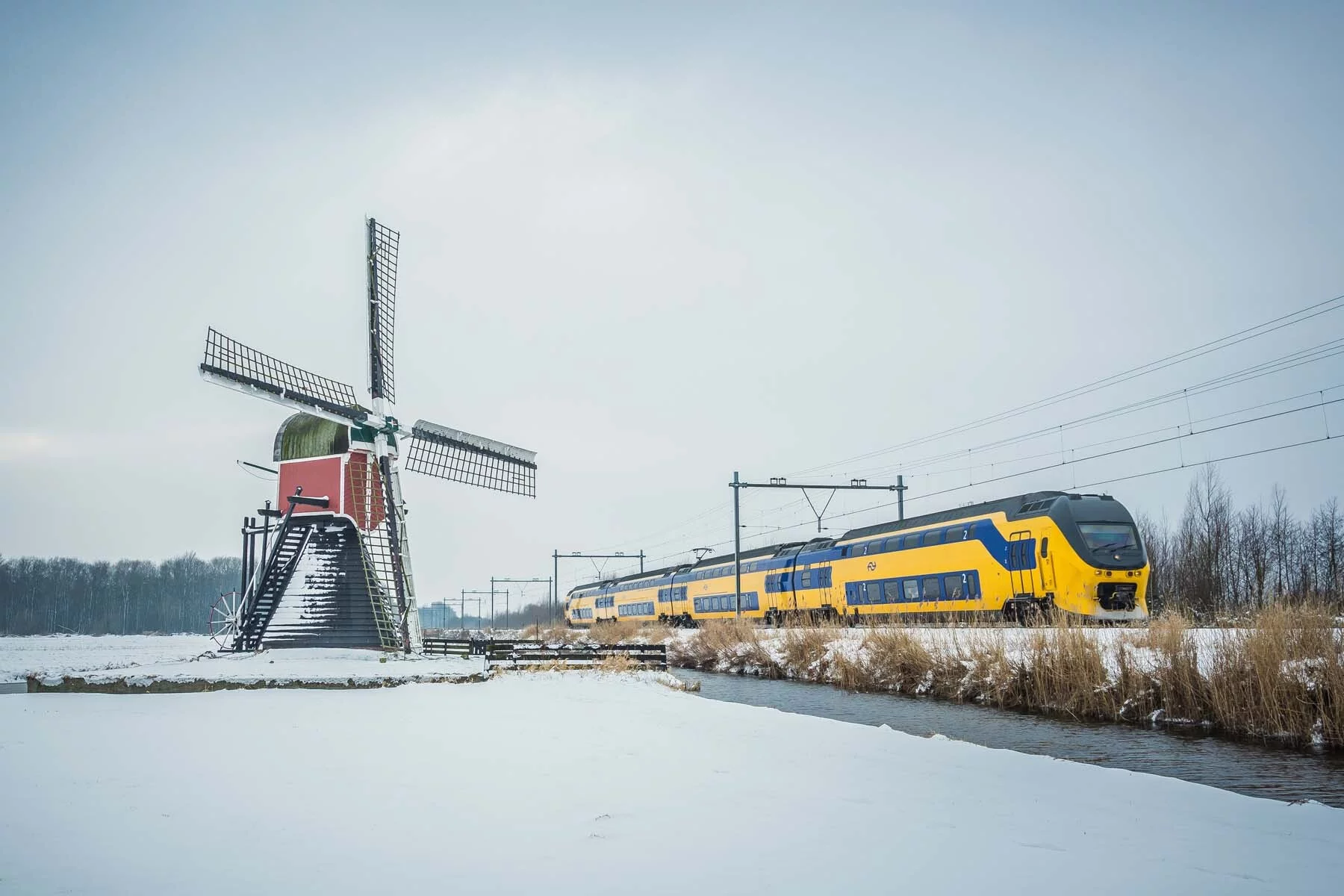
Dutch trains are operated by NS (Nederlandse Spoorwegen). Some regions have additional train companies operating their network (for example, Arriva Netherlands in the north, east, and south of the country). There are two types of NS trains to look out for: the Sprinter and the Intercity. Rather confusingly, the Sprinter is the slower of the two, stopping at all local stations. On the other hand, Intercity services only stop at major stations, ensuring a quicker and more comfortable journey. Most trains have toilets on board, although some older Sprinter trains don’t, so you may want to use the toilets at your departure station.
Trains in the Netherlands are almost always reliable and well-connected, but the railway occasionally faces issues. Services can be canceled due to strong winds, technical difficulties, and staff shortages. Because the network serves so many passengers and trains, a minor incident can have effects on large parts of the network. It’s a good idea to download the NS app to keep an eye on disruptions and updates. If you or a travel companion require special assistance, contact NS ahead of time to ensure you receive the help and support you need. For more information on this, visit the NS’s dedicated web pages.
Train tickets and costs in the Netherlands
Train tickets in the Netherlands are based on the distance and time you travel. While tickets are not especially cheap, prices are in line with other western European countries. The cost of your ticket is usually the same, no matter when you buy it, and you’ll generally pay more to travel during rush hour (de spits: 06:30–09:00 and 16:00–18:30). There are two ways to pay for your train travel: either use your OV-chipkaart credit or buy a ticket. You can buy tickets online or at a ticket office or machine at the station.
One way to make train travel cheaper is with a subscription. Once you have a personal OV-chipkaart, you can pay a set amount each year to benefit from cheaper train travel. There are several schemes, which you can read about on the NS website. And remember, you need at least €10 on your OV-chipkaart (€20 for anonymous cards) before traveling by train in the Netherlands. And don’t forget to check out! Failing to do so could see you get charged the full €20 boarding fare.
Train timetables and maps
In the Randstad, standard train services run from around 05:00 until about midnight. Trains are regular, with some intercity routes having seven or eight journeys per hour. Many local routes often have three or four trips every hour. Night trains also depart once per hour between cities in the Randstad. In cities outside this region, and in more rural areas, you might find the service less regular. Check the NS Journey Planner to find the best route and timetables.
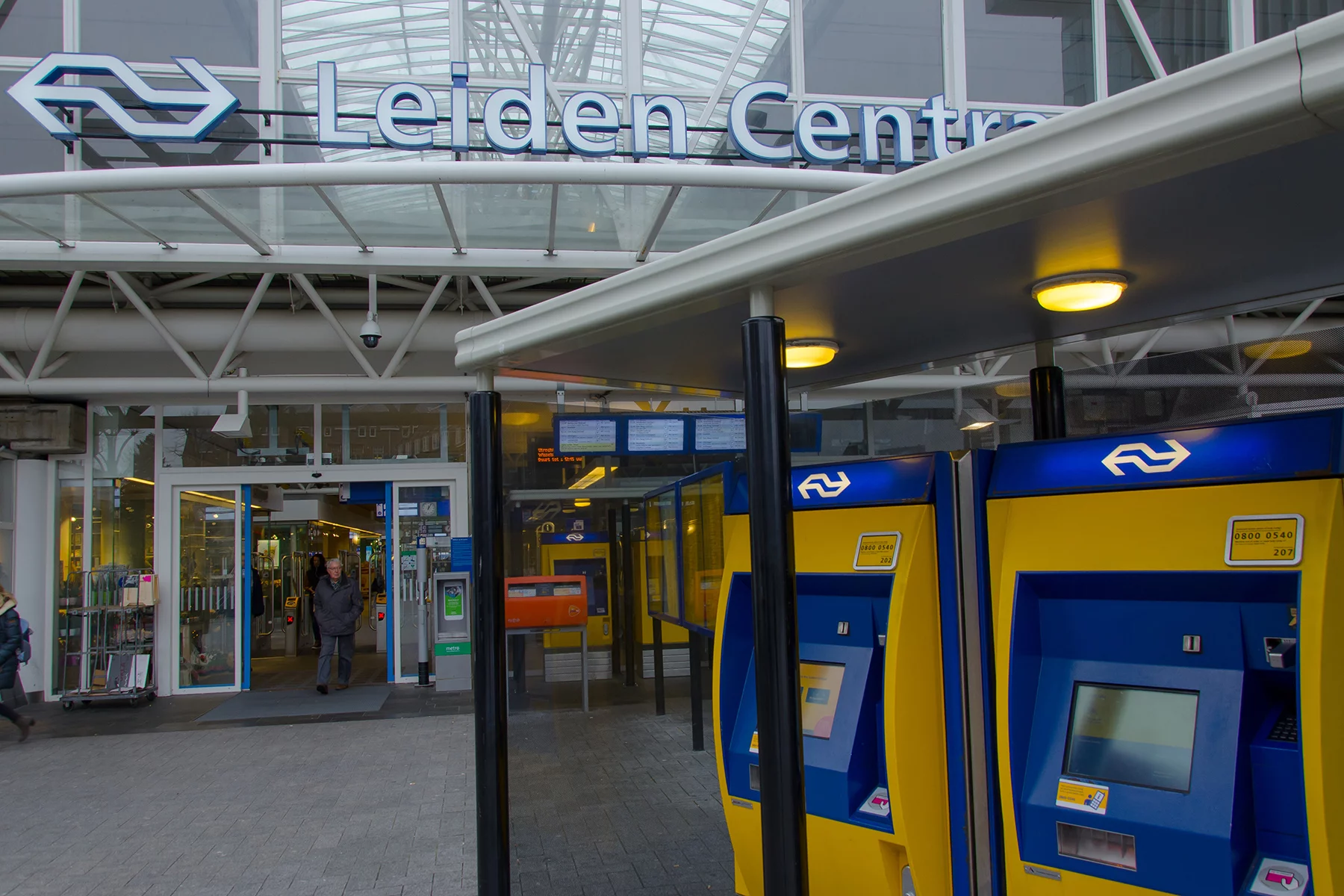
NS also provides up-to-date maps showing the situation on the rails. You can find this on their website or in the NS app. In addition, there are large maps and printed timetables on posters at most stations, as well as electronic displays with information on departures.
Train stations and stops in the Netherlands
Depending on the size of the station, facilities can vary significantly in the Netherlands. At smaller stations, you might find little more than a platform. Larger stations have ticket offices, restaurants, bicycle repairs, workspaces, and even shopping centers. In addition, most stations have toilets which cost about €0.70 to access – you can usually pay with cash or card, and you receive a €0.50 voucher to use at the station. Check the NS website to find out which facilities your local station has.
A great feature of most Dutch stations is the OV-fiets, a bike you can hire for a small daily charge. You need a personal OV-chipkaart, but the subscription costs €0.01 per year, and you can hire up to two bikes at a time. If you return your OV-fiets to another location, you’ll need to pay an additional €10 fee.
City/regional trains in the Netherlands
Sometimes life on the surface can get too much and you need to head underground. Thankfully, the Netherlands has you covered with not one, but two (partially underground) metro systems operating in the country. The most expansive Dutch metro system can be found in Rotterdam/The Hague, serving 70 stations over five lines. Amsterdam’s network is smaller, with 39 stations across five lines.
Due to the popularity of cycling and the compact nature of these cities, the Dutch metro networks are relatively quiet compared to other metro systems like those in London, New York, or Tokyo. However, it can get busy. This is particularly evident during bad weather when locals leave their bikes at home and take the metro. Therefore, be prepared for a busier journey during these days.
International trains in the Netherlands
Want to get away from flat landscapes for the weekend? The Netherlands has multiple international rail connections to cities in Belgium, France, the UK, Germany, and Switzerland. These include:
- Eurostar (Belgium, France, and the UK)
- Intercity Berlijn (Germany)
- Intercity Brussel (Belgium)
- ICE International (Germany/Switzerland)

Many of these trains offer similar facilities to regular Dutch Intercity trains. However, if you catch the Eurostar, you’ll generally find more comfortable seating and a wider range of refreshments and onboard entertainment. Bear in mind that these services also have baggage limits, so check before traveling.
Taking the bus in the Netherlands
As in many other countries, the bus is the most common form of public transportation in the Netherlands. So whether you’re living in a rural area away from the rail network or traveling around towns or cities, it’s likely that a bus will be your best bet. But that’s not a problem, because Dutch bus services are generally pretty efficient.

The operators of Dutch bus networks vary across the country, but you’ll be able to use your OV-chipkaart on all of them. Some buses run on more local routes, often stopping both in and outside urban areas. However, recent years have seen more direct intercity bus lines set up that connect popular regions. Many commuters use these and often find them quicker and more convenient than the train.
There are several different bus operators, such as GVB, Arriva, Connexxion, HTM, and RET. Some buses have WiFi and USB sockets so you can work on the go. Most of the time, you’ll need to enter the bus through the front door and exit through the back door.
Bus tickets and costs in the Netherlands
When catching the bus, you can either buy a ticket from the driver or check in and out with your OV-chipkaart. Some providers also allow you to purchase tickets online. If you are caught without a ticket or forget to check out, you are likely to face a fine.
If you travel often, it’s a good idea to buy a season ticket, which can save you money on your bus journeys. Check your local bus provider’s website to find out what they offer. In addition, people over retirement age can travel for a discounted fee or for free in many cities, and some municipalities allow young children to ride the bus for free.
Bus timetables and maps in the Netherlands
In the Netherlands, buses run from around 05:00 until just after midnight. In cities, buses are fairly regular, with departures every 10–15 minutes. However, rural buses generally have fewer facilities and depart less often. Amsterdam also has night buses, which run once per hour. You can check bus timetables and maps on your transport app or via the bus operator’s website. In addition, many bus stops have schedules, and bus shelters often display route maps.
Bus stations and stops in the Netherlands
You’ll usually find bus stations with multiple bus routes at the main stations in cities. Meanwhile, you can usually spot a Dutch bus stop by its bus shelter, a small sign denoting it as a bus stop, and, sometimes, a live departure board. It’s a good idea to stand up and move to the bus stop sign as the bus approaches, as some drivers don’t stop if they only see people sitting in the shelter.
Taking a Dutch taxi
With all these transportation options – as well as walking and cycling – you might not consider taking a cab. But for many situations, taxis can be the most convenient form of transit. Luckily, it’s fairly easy to catch a taxi in the Netherlands, as most towns and cities have taxi ranks near prominent attractions, stations, and ports.
Taxis in the Netherlands are metered and, generally speaking, charge similar rates. Alternatively, you can negotiate a fixed fare with your driver before you start your journey. Shared taxis are available in many Dutch towns, although you won’t find them in the larger cities. It’s also worth noting that Uber only operates in the largest Dutch cities. You can find cheaper taxi fares on taxi platforms like Sneleentaxi, which connect passengers with taxi drivers across the Netherlands.
Coach travel in the Netherlands
The Netherlands is a relatively compact country, so you might not think of hopping on a coach when considering moving between its major towns and cities. However, coach travel can be a convenient – and cheaper – alternative to taking the train or hiring a car. Companies like Flixbus offer competitive rates and cover the country’s largest towns and cities.
International coach travel is also an option in the Netherlands if you’re thinking about traveling across the border. International operators like Megabus and National Express offer services to the UK, while Flixbus connects major Dutch cities to destinations across Europe, from Lisbon in the west to Bucharest in the east. Bear in mind that coach stations and stops aren’t always in the most obvious places and are often located on the edges of cities and towns. Check locations ahead of time to avoid disappointment.
On longer journeys, coaches will take comfort breaks at rest stops along the way, where you’ll be able to buy refreshments and use the restrooms. If you’re traveling internationally, make sure you take your passport if you need one.
Dutch airports
Flying to warmer climes? You’ll probably be departing from one of the Netherlands’ five airports. These can be found in Maastricht, Rotterdam, Groningen, and Eindhoven. Plans to expand Lelystad Airport in Flevoland are currently ongoing. However, the largest Dutch airport by far is Amsterdam Airport Schiphol. One of Europe’s busiest airports, Schiphol is a short train ride from central Amsterdam and has flights around the world.
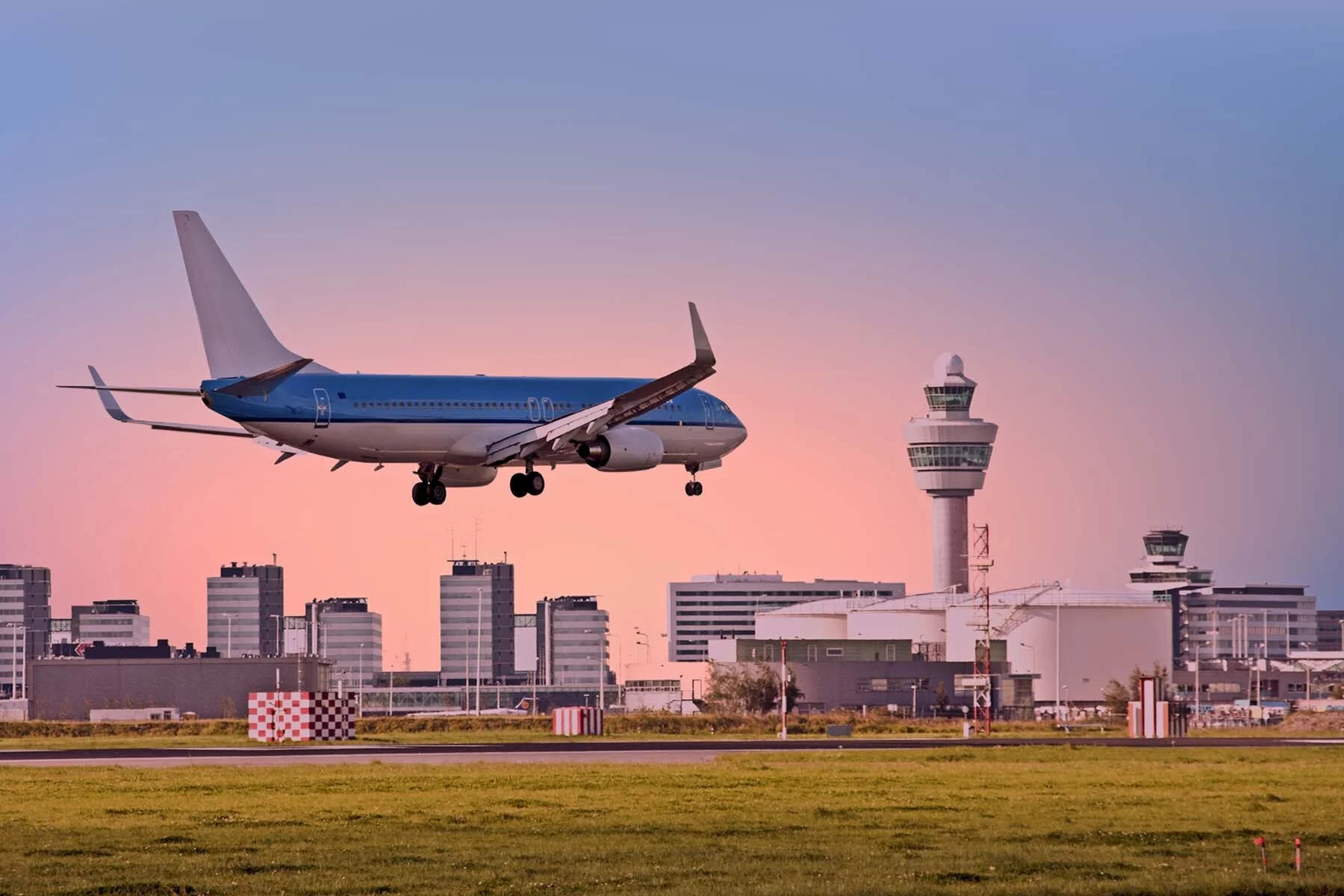
The flag carrier for the Netherlands is KLM Royal Dutch Airlines (Koninklijke Luchtvaart Maatschappij). There are also several low-cost airlines, including Transavia and TUI fly Netherlands.
Amsterdam Airport Schiphol
Amsterdam Airport Schiphol is the Netherlands’ biggest airport and the second busiest in the world by international passenger traffic. In 2021, it saw nearly 25 million passengers pass through, down from almost 72 million in 2019. Located about 10 kilometers from Amsterdam, it serves the Greater Amsterdam area. It has a considerable amount of facilities including places to eat, shopping, and even a spa.
Due to Schiphol’s proximity to Amsterdam, accessing the airport is easy and can be done via train or bus. Schiphol is well-connected to other parts of the Netherlands, meaning that many locals will fly into Schiphol and take a train for their onward journey home. As well as car parking, the airport has plenty of bicycle parking.
Eindhoven Airport
The Netherlands’ second largest airport is Eindhoven Airport. This airport is primarily a hub for budget airlines, including Transavia, Ryanair, and Wizz Air. Most of its destinations are in Europe.
To reach the airport, you can catch the train to Eindhoven Centraal and from there, the 400 or 401 bus. There are also taxis and parking available.
Rotterdam The Hague Airport
Rotterdam The Hague Airport serves Rotterdam and The Hague. Flights from this airport go mostly to holiday destinations in Europe and Morocco. There is car, motorbike, and bicycle parking at the airport, but it’s also easy to reach it by public transport. Metro line E runs between Rotterdam and The Hague, stopping near the airport. From the metro, you can catch bus 33.
Other methods of public transportation in the Netherlands
Traveling by tram in the Netherlands
If you want to take in the beautiful Dutch streets while not actually walking or cycling, there are few things better than taking the tram. The four largest cities in the Netherlands each have their own tram system: Amsterdam, Rotterdam, The Hague, and Utrecht. Of these, Amsterdam has the most extensive network, with 500 tram stops along 15 lines.
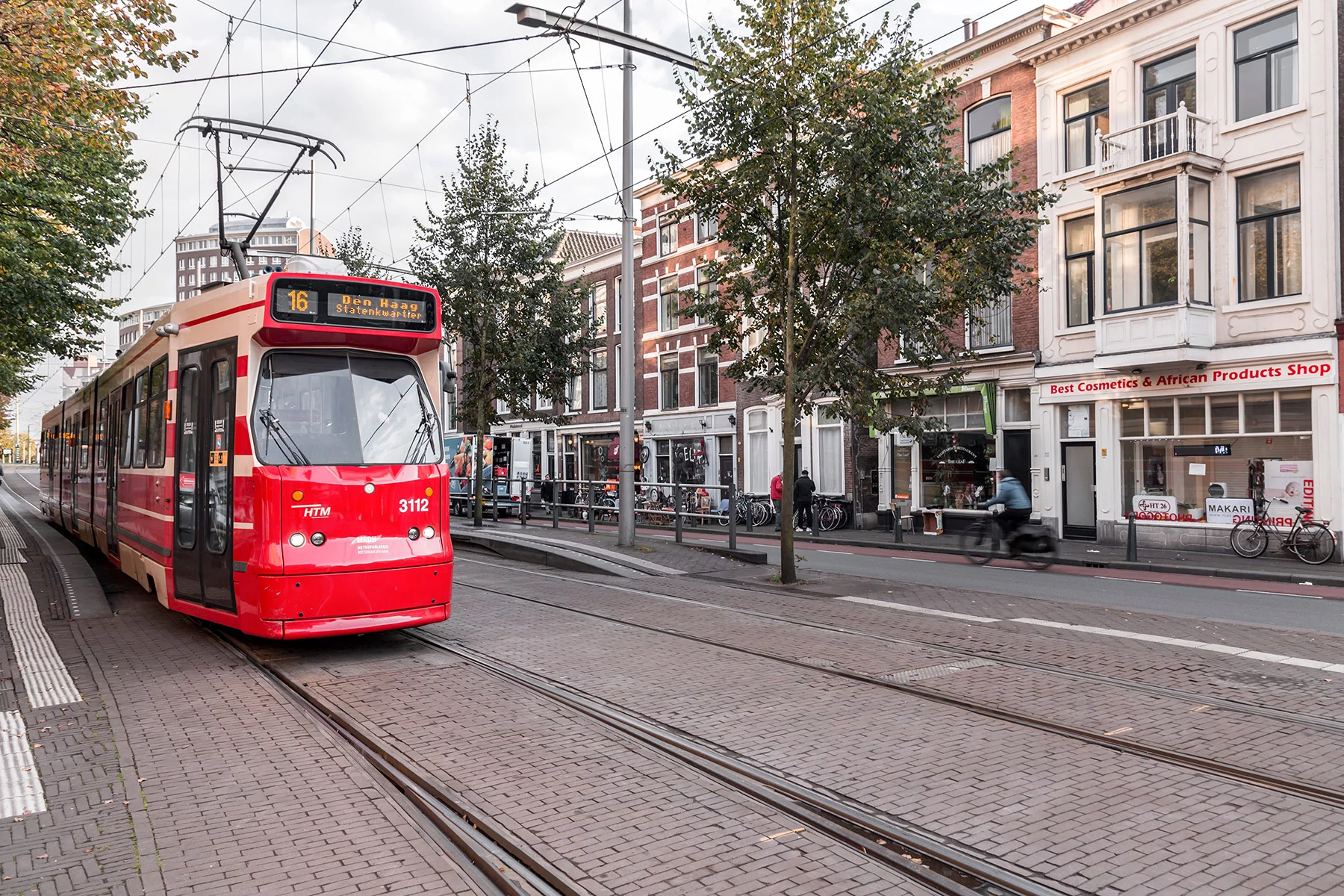
When it comes to public transportation in the Netherlands, trams are generally the quickest way to move through crowded city centers. However, they also double up as excellent ways to see the city. In fact, National Geographic hailed Amsterdam’s Tram 2 as one of the world’s best tram routes. Starting at Centraal Station, it showcases some of the city’s best attractions, including the Royal Palace and Rijksmuseum.
Tips for taking the tram in the Netherlands
Read our top tips for tram travel:
- You’ll be able to use your OV-chipkaart across the country, but don’t forget to check-in and check-out to avoid any hefty ticketing fees.
- Generally speaking, you’ll be able to buy a ticket on board from the conductor. Their desk is around halfway down the tram, and most conductors can speak English.
- Trams won’t necessarily stop where you need to get off, so make sure you push the stop button to avoid having to loop back on yourself.
- When alighting the tram, be careful of your surroundings. Many tram routes are in busy areas and the next tram may only be a few seconds behind, so keep your wits about you.
Ferries in the Netherlands
Ferries might not be your first port of call when you think about public transportation, but in the Netherlands, your nearest one might be your best option. In Amsterdam, free ferries transport cyclists and pedestrians across the IJ. Services run all night and offer an unmistakably Amsterdam experience should you be looking for one.
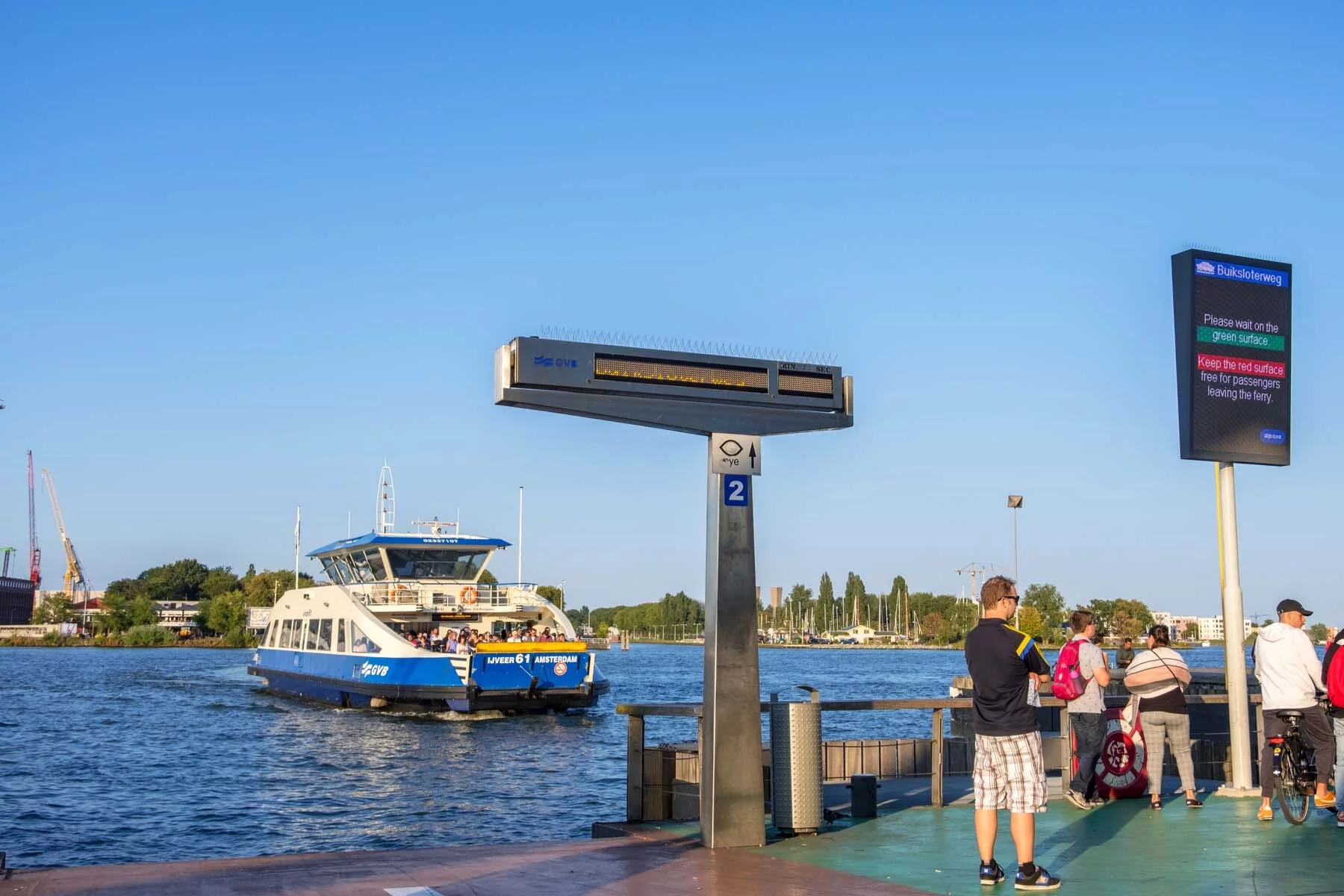
However, these aren’t the only ferries in the Netherlands. Along some rivers, you’ll find pedestrian and cycle ferries making the crossing. Some are manned, while others you have to operate yourself. There are also ferries connecting the mainland to the northern islands, such as Texel. Check ahead to avoid disappointment, particularly if planning a cycling trip, as you may need to detour over the nearest bridge if the ferry isn’t running.
Tips for traveling by ferry in the Netherlands
Before leaving dry land, read these top tips for ferry travel:
- When boarding the IJ ferries in Amsterdam, always move to the front of the boat to allow others to board behind you. When you arrive, move away promptly to allow others to disembark safely.
- Some river ferries only operate seasonally or on certain days. Do your research ahead of time so you don’t get left stranded.
Public transportation discounts in the Netherlands
There are several forms of public transportation discounts in the Netherlands. These usually apply to retired people, children, youths, and those with a disability. You can find out which discounts you’re entitled to on the webshop of your local public transport company (for local buses and trams) or via NS (trains). Although Dutch students can travel for free, unfortunately, there are no discounts available for international students. That said, if you use public transport often, you can usually buy a season ticket or subscription to make your journey cheaper.
For example, these are some of the train discounts available:
- Dal Voordeel – €2.50 per month, 40% savings on off-peak tickets for you and up to three fellow travelers
- Dal Vrij – €107.90 per month, unlimited free off-peak travel
- Altijd Vrij – €362.49 per month, unlimited free travel
How disability-accessible is public transportation in the Netherlands?
Some aspects of public transport in the Netherlands are very accessible. For example, you can book NS Travel Assistance when traveling by train, and a trained assistant will help you on your journey. You should book this at least one hour before departure. You can also bring your wheelchair, mobility scooter, specialized bicycle, or guide dog with you for free, but mobility aids have to meet certain conditions. Ramps are available at stations and trains have space for wheelchair users. The OV-chip Plus card allows people with a visual impairment to book their tickets by phone or online or use a season ticket, without having to check in and out.
Finding accessible buses and trams, on the other hand, can be trickier. While many buses have a sliding platform for wheelchair access, and many trams have wheelchair-suitable entrances, some leave a lot to be desired. For example, you might find that some trams have a small set of stairs to enter, and that some stops are not accessible for those using mobility aids. Check with your local transport authority to find out more about your options.
How environmentally friendly is public transportation in the Netherlands?
Traveling by public transport is a great way to cut down on your emissions and live sustainably. Happily, sustainability appears to be high on the Dutch transportation agenda. Trains rely mostly on renewable energy, and NS aims to eliminate its use of fossil fuels by 2040. When it comes to local transport, many municipalities run electric buses and seek to reduce their emissions to zero in the coming decade. According to the Dutch Authority for Consumers & Markets, The Hague has the most sustainable transit network in the country.
Public transportation safety tips in the Netherlands
According to a 2019 survey, most people feel ‘safe’ or ‘very safe’ on Dutch public transport. That said, uncomfortable situations can arise, so keep these handy tips in mind:
- If you’re going to a new place, plan your route in advance and either have someone meet you, or call someone to let them know you’ve arrived safely.
- When the whistle goes on the platform, and the train doors start closing, don’t try to jump on, as you could injure yourself. Trains go very regularly in the Netherlands, so you might as well wait for the next one.
- If you are on the train and witness aggressive behavior or an unsafe situation, you can contact NS via WhatsApp or text message on 06 13 18 13 18. Train staff are usually present and easy to spot, so you can also ask them for assistance.
- In an emergency, call 112 for emergency services.
You can read more on train safety on the NS website.
Making a public transportation complaint in the Netherlands
If something hasn’t gone to plan with your journey, your first step should be to contact the transport company, such as NS. Train companies usually also offer a refund for journeys delayed more than 30 minutes, although this is based on several conditions. If you are unhappy with the service you have received, you can escalate the complaint to the Klachtenloket Openbaar Vervoer.
